Method of key allocation as cell as encryption and decryption protocols based on discrete logarithm problem on subcluster
A discrete logarithm problem and key distribution technology, which is applied in the field of cryptography and information security, and can solve the problems of increasing the difficulty of cryptanalysis, and the lack of key distribution and encryption and decryption methods.
- Summary
- Abstract
- Description
- Claims
- Application Information
AI Technical Summary
Problems solved by technology
Method used
Image
Examples
Embodiment 1
[0225] Embodiment 1, using a one-variable polynomial ring R under multi-modular operations to construct a zero-factor subgroup S and implement a key distribution protocol
[0226] A simple example of using two-level nonlinear algebraic expansion, using R[v(y)] as R is as follows:
[0227] Set the parameters: n=2, d=2, h=3, e 1 =e 2 =2, s=3, k=2, m=30967 (the prime decomposition of m is 173×179)
[0228] u(x)=x 3 +10331x 2 +29191x+15575
[0229] v(y)=y 2 +(22823x 2 +23508x+17188)y+(25335x 2 +15462x+8727)
[0230] The coefficients used in the first layer of nonlinear transformation are
[0231] g 1,1 =(4973x 2 +23767x+18329)y+(23747x 2 +15427x+1693)
[0232] g 1,2 =(6007x 2 +9721x+24439)y+(8543x 2 +2267x+28909)
[0233] The coefficients used in the second layer nonlinear transformation are
[0234] g 2,1=(1373x 2 +23053x+13331)y+(22273x 2 +17x+10771)
[0235] g 2,2 =(3989x 2 +24239x+10459)y+(19471x 2 +30631x+2837)
[0236] After constructing a subgroup with zero factors, the followi...
Embodiment 2
[0254] Example 2, using the remaining ring-like Z m The matrix ring on is constructed with zero factor subgroup S
[0255] Set parameters: n=2, h=5, modulus m=30967 (prime decomposition is 173×179), matrix dimension s=2, coefficient: g 1 = 22908, g 2 =25701, base A={A 1 , A 2 }, respectively
[0256] A 1 = {14419, 11240,
[0257] 19910, 18552}
[0258] A 2 = {21901, 19947,
[0259] 30530, 5692}
[0260] Let L a = 13177, L b = 8754. Using the most basic exponentiation rule, the experimental results of interactive key distribution are as follows:
[0261] Party A calculates A's L a Power: B a ={B a1 , B a2 }, respectively
[0262] B a1 ={17788,5679,
[0263] 18961, 7429}
[0264] B a2 = {4356, 6364,
[0265] 30955, 16037}
[0266] Party B calculates A's L b Power: B b ={B b1 , B b2 }, respectively
[0267] B b1 = {5000, 4790,
[0268] 18803, 14817}
[0269] B b2 = {5063, 20666,
[0270] 28003, 30615}
[0271] Party A calculates B b L a Power: K a ={K a1 , K a2 }, respectively
[027...
Embodiment 3
[0282] Example 3, using finite field F p Construct zero-factor subgroup T
[0283] Let n=4, h=2, e=3, F p The characteristic of P=32749, the base A={6469,21211,18047,13859}, the coefficient g 0 = 10739, g 1 = 30403, g 2 = 9479, g 3 = 9461, g 4 =32189, using the most basic exponentiation rule, the experimental results of interactive key distribution are as follows:
[0284] Let L a = 51761, L b =45233.
[0285] Party A calculates A's L a Power: B a = {25044, 9122, 1891, 20748};
[0286] Party B calculates A's L b Power: B b = {18605, 23601, 11904, 9278};
[0287] Party A calculates B b L a Power: K a = {25087, 32180, 20024, 15618};
[0288] Party B calculates B a L b Power: K b = {25087, 32180, 20024, 15618}.
[0289] It can be seen that K a And K b The calculated results are the same.
PUM
 Login to View More
Login to View More Abstract
Description
Claims
Application Information
 Login to View More
Login to View More - R&D
- Intellectual Property
- Life Sciences
- Materials
- Tech Scout
- Unparalleled Data Quality
- Higher Quality Content
- 60% Fewer Hallucinations
Browse by: Latest US Patents, China's latest patents, Technical Efficacy Thesaurus, Application Domain, Technology Topic, Popular Technical Reports.
© 2025 PatSnap. All rights reserved.Legal|Privacy policy|Modern Slavery Act Transparency Statement|Sitemap|About US| Contact US: help@patsnap.com



